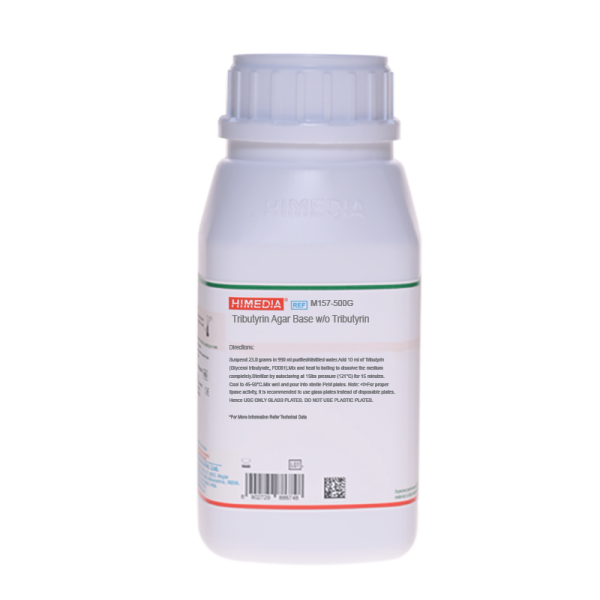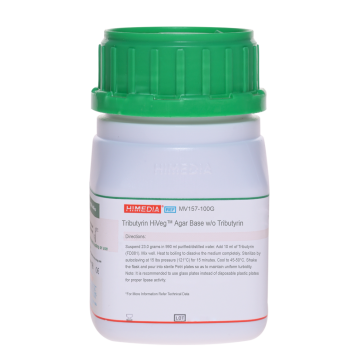 Your enquiry has been submitted
Your enquiry has been submitted
Tributyrin Agar Base w/o Tributyrin
Intended Use
Recommended for detection of lipolytic microorganisms.
Composition**
| Ingredients | Gms / Litre |
|---|---|
| Peptone | 5.000 |
| Yeast extract | 3.000 |
| Agar | 15.000 |
Final pH ( at 25°C): 7.5±0.2
**Formula adjusted, standardized to suit performance parameters
Directions
Suspend 23 grams in 990 ml purified / distilled water. Add 10 ml of Tributyrin (FD081). Mix and heat to boiling to dissolve the medium completely. Sterilize by autoclaving at 15lbs pressure (121°C) for 15 minutes. Cool to 45-50°C. Mix well and pour into sterile Petri plates.
Note : For proper lipase activity, it is recommended to use glass plates instead of disposable plates. Hence USE ONLY GLASS PLATES. DO NOT USE PLASTIC PLATES.
Principle And Interpretation
Many foods contain significant amount of fats that may be susceptible to hydrolysis. The free fatty acids (FFA) liberated by hydrolysis of fat can be responsible for unpleasant flavous or they may oxidize to compounds with undesirable flavour notes. Many of the problems of fat breakdowns in foods are non-microbial in origin, but numerous bacteria, yeasts and moulds produce lipolytic enzymes that are capable of causing both hydrolytic and oxidative deterioration of fats when present in food samples (12).
Lipolytic enzymatic activities of microorganisms are one of the most important causes for food spoilage and a limited shelf life. Tributyrin Agar was originally formulated by Anderson (3) for the detection and enumeration of lipolytic microorganisms such as Staphylococci (7), Clostridia (13), marine Flavobacteria and Pseudomonas (6) and moulds in foodstuffs and other materials.
Tributyrin is the simplest triglyceride occurring in natural fats and oils. It is hydrolyzed by some microorganisms that do not hydrolyze other triglycerides or fats containing longer chain fatty acids. However, for screening purposes, to enumerate lipolytic microorganisms of potential importance in foods, it is the substrate of choice (1,5).
Peptone and yeast extract in the medium provide nutrients to the organisms. Tributyrin degradation by the microorganisms is indicated by clear zones surrounding the lipolytic colonies in the otherwise turbid culture medium. Lipolytic organisms render the medium transparent by converting the fat to water soluble butyric acid (4). The medium should have a uniform turbid emulsion for the effectiveness of the assay (10).
Type of specimen
Food and dairy samples
Specimen Collection and Handling
For food and dairy samples, follow appropriate techniques for sample collection and processing as per guidelines (2,11,14). After use, contaminated materials must be sterilized by autoclaving before discarding.
Warning and Precautions
Read the label before opening the container. Wear protective gloves/protective clothing/eye protection/ face protection. Follow good microbiological lab practices while handling specimens and culture. Standard precautions as per established guidelines should be followed while handling specimens. Safety guidelines may be referred in individual safety data sheets.
Limitations
- 1. This medium is general purpose medium and may not support the growth of fastidious organisms.
Performance and Evaluation
Performance of the medium is expected when used as per the direction on the label within the expiry period when stored at recommended temperature.
Quality Control
Appearance: Cream to yellow homogeneous free flowing powder
Gelling: Firm, comparable with 1.5% Agar gel
Colour and Clarity of prepared medium: Light yellow coloured opalescent gel forms with oil droplets in Petri plates.
Reaction: Reaction of 2.3% w/v aqueous solution containing 1% Tributyrin at 25°C. pH : 7.5±0.2
pH: 7.30-7.70
Cultural Response: Cultural characteristics observed after an incubation at 35-37°C for 24-48 hours with added Tributyrin (FD081) (under appropriate conditions).
| Organism | Inoculum (CFU) | Growth | Lipase activity |
|---|---|---|---|
| Clostridium perfringens ATCC 12924 | 50-100 | luxuriant | negative, absence of clear zone around colony |
| Clostridium sporogenes ATCC 11437 | 50-100 | luxuriant | positive, clear zone around colony |
| Bacillus subtilis subsp. spizizenii ATCC 6633 (00003*) | 50-100 | luxuriant | positive, clear zone around colony |
| Escherichia coli ATCC 25922 (00013*) | 50-100 | luxuriant | negative, absence of zone around colony |
| Staphylococcus aureus subsp. aureus ATCC 25923 (00034*) | 50-100 | luxuriant | positive, clear zone around colony |
Key : *Corresponding WDCM numbers.
Storage and Shelf Life
Store between 10-30°C in a tightly closed container and the prepared medium at 2-8°C. Use before expiry date on the label. On opening, product should be properly stored dry, after tightly capping the bottle in order to prevent lump formation due to the hygroscopic nature of the product. Improper storage of the product may lead to lump formation. Store in dry ventilated area protected from extremes of temperature and sources of ignition. Seal the container tightly after use. Use before expiry date on the label. Product performance is best if used within stated expiry period.
Disposal
User must ensure safe disposal by autoclaving and/or incineration of used or unusable preparations of this product. Follow established laboratory procedures in disposing of infectious materials and material that comes into contact with sample must be decontaminated and disposed of in accordance with current laboratory techniques (8,9).
Reference
- Alford J. A., and Steinle E. E., 1967, J. Appl. Bacteriol., 30: 488
- American Public Health Association, Standard Methods for the Examination of Dairy Products, 1978, 14th Ed., Washington D.C.
- Anderson J. A., 1939, Ber, IIIrd Int. Mikrobiol. Kongress, 3 : 726
- Collee J. G., Fraser A. G., Marmion B. P., Simmons A., (Eds.), Mackie and McCartney, Practical Medical Microbiology, 1996, 14th Edition, Churchill Livingstone.
- Frayer T. T., Lawrence R. C., Reiter B, 1967, J. Dairy Sci., 50: 477.
- Hayes P. R., 1963, J. Gen. Microbiol., 30: 1
- Innes A. G., 1956, J. Appl. Bacteriol., 19: 39
- Isenberg, H.D. Clinical Microbiology Procedures Handbook 2nd Edition.
- Jorgensen, J.H., Pfaller, M.A., Carroll, K.C., Funke, G., Landry, M.L., Richter, S.S and Warnock., D.W. (2015) Manual of Clinical Microbiology, 11th Edition. Vol. 1.
- MacFaddin J. F., 1985, Media for Isolation-Cultivation-Identification-Maintenance of Medical Bacteria, Vol. 1, Williams and Wilkins, Baltimore
- Salfinger Y., and Tortorello M.L. Fifth (Ed.), 2015, Compendium of Methods for the Microbiological Examination of Foods, 5th Ed., American Public Health Association, Washington, D.C.
- Vanderzant C. and Splittstoesser D. F., (Eds.), 1992, Compendium of Methods for the Microbiological Examination of Foods, 3rd Ed., APHA, Washington, D.C.
- Willis A. T., 1960, J. Path. Bacteriol., 80 (2): 379
- Wehr H. M. and Frank J. H., 2004, Standard Methods for the Microbiological Examination of Dairy Products, 17th Ed., APHA Inc., Washington, D.C.
| Product Name | Tributyrin Agar Base w/o Tributyrin |
|---|---|
| SKU | M157 |
| Product Type | Regular |
| Physical Form | Powder |
| Origin | Animal |
| Packaging type | HDPE |
| References | 1. Alford J. A., and Steinle E. E., 1967, J. Appl. Bacteriol., 30: 488 2.American Public Health Association, Standard Methods for the Examination of Dairy Products, 1978, 14th Ed.,Washington D.C. 3.Anderson J. A., 1939, Ber, IIIrd Int. Mikrobiol. Kongress, 3 : 726 4.Collee J. G., Fraser A. G., Marmion B. P., Simmons A., (Eds.), Mackie and McCartney, Practical Medical Microbiology, 1996, 14th Edition, Churchill Livingstone 5.Frayer T. T., Lawrence R. C., Reiter B, 1967, J. Dairy Sci., 50: 477. 6.Hayes P. R., 1963, J. Gen. Microbiol., 30: 1 9.Jorgensen, J.H., Pfaller, M.A., Carroll, K.C., Funke, G., Landry, M.L., Richter, S.S and Warnock., D.W. (2015) Manual of Clinical Microbiology, 11th Edition. Vol. 1. 10.MacFaddin J. F., 1985, Media for Isolation-Cultivation-Identification-Maintenance of Medical Bacteria, Vol. 1,Williams and Wilkins, Baltimore 2.Vanderzant C. and Splittstoesser D. F., (Eds.), 1992, Compendium of Methods for the Microbiological Examination of Foods, 3rd Ed., APHA, Washington, D.C.1 3.Willis A. T., 1960, J. Path. Bacteriol., 80 (2): 37914.Wehr H. M. and Frank J. H., 2004, Standard Methods for the Microbiological Examination of Dairy Products, 17th Ed.,APHA Inc., Washington, D.C |
| Customized Product Available | No |






